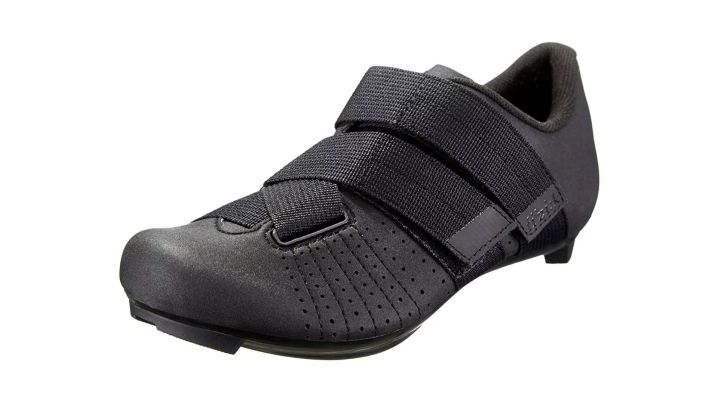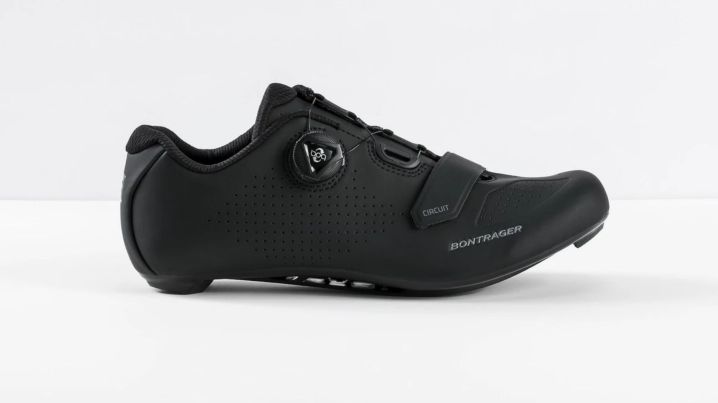We may earn revenue from the products available on this page and participate in affiliate programs.

When I first started cycling, one of my first questions was, “Will I die if I wear those shoes?” My second question was, “What’s up with those shorts?” — but I suppose this guide isn’t about that. But those shoes. I was fascinated as I watched my wife, a cyclist of many years, lock her feet into pedals, and wondered how she didn’t break a bone whenever the rare but inevitable crash occurred. I mean, you have to twist your ankle to click out, and I wondered whether I would have the presence of mind to perform this task in time to prevent an injury if I crashed.
It turns out, as I discovered much later than I should have, cycling shoes aren’t nearly as complicated as they look. With just a little practice, they become second nature. But more importantly, they transformed my cycling experience. I found my speed and efficiency improved significantly, and I didn’t have to fight so hard to keep up with my wife.
There’s a lot of brands out there to choose from though, and even if you’ve been riding a while, it’s sometimes hard to figure out what shoes are worth your time. So we’ve done the research for you to help you find the perfect shoes to help you up your game and blow past your personal records.
Best Overall
Specialized S-Works 7
Best Value
Fizik Tempo Powerstrap R5
Editor’s Choice
Bontrager Circuit
Best for Beginners
Shimano SH-RC100
Best for Mountain Biking
Giro Chamber II
Best Racing Cycling Shoes
Fizik Vento Powerstap R2 Aeroweave
Best Alternative to Cycling Shoes
YBEKI cage pedals with toe clips and straps
Why you should trust us
We are obsessed with all things gear-related, including fitness equipment. Our team lives to get our hands on everything our readers might be interested in to evaluate them and make sure they’re up to the task you need them for. I’ve personally been cycling for about a decade, and have transitioned from flat pedals to cage pedals, and then to cycling shoes and clipless pedals over the years. So I’ve managed to break a few things (no bones though) along the way. Now I can share some of those lessons with you.
Types of cycling shoes
Road cycling shoes
The purpose of the road cycling shoe is to connect your foot to the pedal in such a way as to not only maximize the efficiency of your downward pedaling, but also as your foot lifts so you have a near-continuous transfer of power propelling you down the road. To this end, the more stiff the sole, the more efficient you can be (but also the more uncomfortable, at least until you get used to it).
Mountain biking shoes
Although it has a similar mission to the road cycling shoe, the mountain bike shoe achieves it in quite a different fashion. These cycling shoes are made to take more abuse, are more durable, and are often water-resistant. The outsoles, while stiff, are by necessity made to flex. This is partly because your feet need to be able to sense changes in the trail that you can feel while riding, and then to be able to respond. It also helps when you have to stand and shift your weight as you take corners and navigate technical trails. Plus, when you have to stop and pick up your bike, you don’t want to “Frankenstein walk” over a fallen log. Also, these shoes use a different cleat system (two bolts vs the three bolts used by road shoes).
Indoor cycling shoes
These shoes are made to maximize your stationary bike workout and are usually like regular road or mountain bike shoes in most respects. Most of your outdoor shoes will work fine, so long as you have the proper cleats to match the pedals. Specialized indoor shoes do exist, of course, and are made to provide enhanced ventilation for those hot inside rides.
Key features of cycling shoes
Everything about a cycling shoe is ultimately about “power transfer,” which means making your pedaling as efficient as possible. This is done largely through the design of the upper and sole. Ensuring a secure and comfortable fit is a large part of the shoe closure system.
Upper
This is the part of the shoe that covers the top of your foot and connects to the bottom (sole). A good upper will be well-ventilated because cycling is hard work and you want your feet to breathe. Cycling shoe uppers are generally stiff, and increasingly so as you scale up to more racing-style shoes because this helps keep your feet ideally placed for maximum efficiency.
Sole/outsole
The sole is the soul of the cycling shoe (thank you, please tip your server). It provides the platform where your foot rests and the shoe connects to the cleat/pedal. The stiffer the sole, the better the power transfer (but also, the more uncomfortable for those unaccustomed to them). The sole is typically made of nylon, nylon/fiberglass, or carbon (in premium shoes).
Closure system
This closure system of a cycling shoe doesn’t just tighten and secure your foot in the shoe, but it also helps the upper conform to your foot, which enhances comfort and increases pedaling efficiency. There are three types of closure systems you’ll typically find on modern shoes: laces, which operate like your traditional shoe; Velcro straps, which work well at adjusting the upper around your feet but are not easy to adjust after you start riding; and dialing systems, like the BOA adjustable dials. These tighten strong laces by twisting a small dial (or two, or even three). They’re great for micro-adjustments to ensure a great fit and are easy to tweak on the ride.
Benefits of cycling shoes
Power transfer
This is why you get these shoes. Cycling can be fun and enjoyable, but at the end of the day, it’s an exercise and a sport. Cycling shoes ensure you get the most out of your ride by transforming all your pedaling motion into power.
Confidence
There’s something to be said about mastering the right gear. Not everyone needs or wants to be a cyclist. Some just want to get out every once in a while and ride without the shoes, the shirts, and those awful pants. That’s fine. But when you’re ready to get serious, the right shoes demonstrate that you’re ready to push yourself to the next level of performance.
Fitness
The increased performance from more efficient power transfer, and the improved ride experiences that come from your increased confidence both lead to longer and more productive workouts. You’ll find that when you’re using cycling shoes, your speed increases, and longer distances become more attainable. That leads to next-level workouts that result in better fitness. You still have to put in the work and the sweat, but the right shoes will help you get there.
Cycling shoe pricing
Budget
Cycling shoes in this category can be around $100 or so. Typically, the soles of a budget shoe provide a mid-range stiffness rating (e.g., a six on a scale from 1-12), and rigid but not overly stiff uppers. The cost of these shoes is kept lower by using slightly heavier, less durable nylon composites for the soles and nylon material for the upper.
Also, the closure systems tend to be lace or Velcro straps. Ironically, these shoes can be quite comfortable compared to the more premium brands, since they’re not as stiff, with the downside being they aren’t as efficient. For the beginning cyclist, this is not a bad thing, since you can learn to use the budget shoes and still see marked improvement over not using cycling shoes at all.
Mid-range
Once you get over $100 and up to about $250, you start getting more advanced materials in the shoe, as well as more advanced dial closure systems. The Stiffness Index ratings of soles in this range may still be middle of the road, but the sole material is stronger and lighter, which makes for more comfortable and efficient use. The upper material also becomes stiffer and lighter.
Brands such as Shimano and Specialized also boast about the scientifically guided ergonomics that go into their shoes, allowing for maximum pedaling efficiency.
At the lower end of this range, you’ll often see lower-tier dial closure systems that only twist to tighten, but require you to pull the dial to loosen the lace (a process that isn’t very cumbersome at all, really). But as you climb this range, you’ll find the more advanced dials that both tighten and loosen by turning them.
Premium
Cycling shoes over $250 can be thought of as racing or competition shoes. Some are geared for triathletes. The uppers will use the most advanced, lightweight material (like Dyneema mesh, which is stiff but malleable). The soles will be made of carbon, so they are strong, light, and stiff. These shoes are lightweight, but it’s here where you’ll find the maxed-out stiffness ratings and ergonomically designed soles that squeeze every ounce of performance out of your ride. These are used by the most serious of riders, and frankly not worth the investment unless you’re really looking to maximize your competitiveness.
How we chose our top picks
This guide was put together using a mix of personal experience, expert opinions, and in-depth market research. I’ve found that local bike shops offer a wealth of wisdom on what cyclists like these days, so I talked with some as part of my research.
Next, I made sure to cross-reference my experience and what the local shops were saying, along with what other cycling gear testers had to say. The most useful, I found, were BikeRadar, Cycling Weekly, Cycling News, and Bicycling,com.
Finally, as I started to line up the finalists, I excluded any that had few customer reviews, whether on Amazon, other vendors, or the company product pages, since by combing through actual user experiences you can find whether or not the shoe resonates with the buyer.
FAQs on cycling shoes
You’ve got questions, Task & Purpose has answers.
Q. Do cycling shoes make a difference?
A. Absolutely. I was a skeptic at first, but the increased performance and the power transfer (a phrase I use perhaps 100 times in this guide) is undeniable. Cycling shoes are a must for those wanting to up their cycling game.
Q. Do all bike shoes fit all pedals?
A. No. A bike shoe itself doesn’t fit anything. It needs a cleat (usually sold separately), and you need to make sure the cleat you use is designed to fit the pedal you’re using. For your first shoe, it’s smart to buy the pedal and cleat at the same time.
Q. How stiff should my cycling shoes be?
A. A mid-range stiffness rating is a good place to start. If you’re a more experienced rider looking to improve performance, start moving up the scale.
Q. Is there a uniform stiffness index used by all shoes?
A. No! It’s annoying, but each shoe company uses its own index, so comparison of stiffness between brands is difficult.
Our gear section
W.E. Linde spent 12 years in the Air Force as an intelligence guy and loved both his enlisted and commissioned time. Now a civilian, he toils away as a healthcare business analyst by day and wannabe writer by night because who needs sleep when you have coffee? His time in the military made him appreciate just how funny the term “military grade” can be. He currently writes for Duffel Blog and for the humor site Damperthree.com









